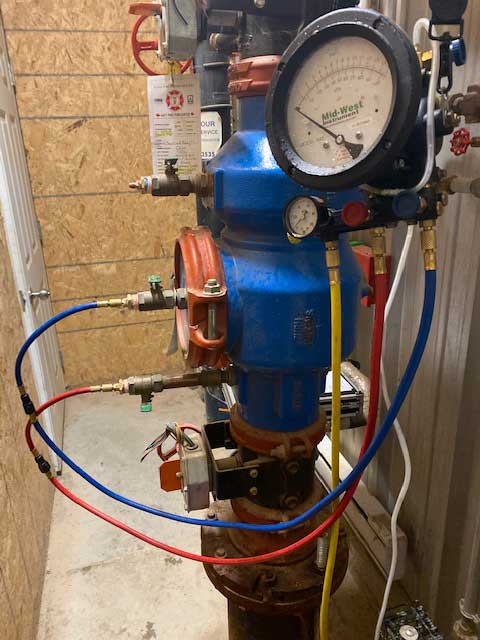BackFlow Testing
Backflow testing involves assessing backflow prevention devices that ensure contaminants do not flow backward into clean water systems.
By conducting regular backflow tests, you safeguard your home, business or community from potential health hazards.
What Is Backflow?
Backflow occurs when the normal flow of water is reversed, allowing potentially harmful contaminants to enter the clean water supply.
This reversal of flow can happen due to changes in pressure within the water system.
For example, if a fire hydrant is opened or a water main breaks, the sudden drop in pressure can cause water to flow backward into the system.
There are two main types of backflow:
- Backsiphonage: This occurs when there is a negative pressure in the supply piping, causing water to be siphoned back into the clean water system. Common causes include a sudden drop in pressure, such as when a nearby fire hydrant is used.
- Backpressure: This happens when the pressure in the system downstream of the backflow prevention device exceeds the supply pressure, forcing contaminated water back into the clean water system. Causes can include thermal expansion or a pump system creating higher pressure.

Both types of backflow can introduce hazardous materials, such as chemicals, bacteria, and other pollutants, into your drinking water. Backflow prevention devices are installed to prevent these dangerous situations.
Why Is Backflow Testing Important?
Backflow testing is essential because it ensures that backflow prevention devices are functioning correctly. These devices are your first line of defense against water contamination, and regular testing confirms that they can handle pressure changes without failing.
Several key reasons highlight the importance of backflow testing:
- Health Protection: Contaminated water can cause severe health issues, including gastrointestinal diseases, chemical poisoning, and even long-term illnesses. By ensuring your backflow prevention devices work correctly, you protect the health of your family, employees, and community.
- Legal Compliance: Many local and state regulations require backflow prevention devices and mandate regular testing. Failure to comply can result in fines, legal action, and even disconnection from the public water supply. Regular testing ensures you stay compliant with these laws.
- Property Safety: Contaminants that enter your water system can cause significant damage to your plumbing, appliances, and other property. Preventing backflow protects your investment and prevents costly repairs.
- Environmental Protection: Backflow can introduce hazardous substances into the broader environment, affecting not only your property but also the local ecosystem. Regular testing helps prevent environmental contamination.
How Is Backflow Testing Conducted?
Backflow testing is a systematic process carried out by certified professionals. Here’s how it typically unfolds:
- Visual Inspection: The technician begins by visually inspecting the backflow prevention device. They check for any obvious signs of wear, corrosion, or damage that could impair the device’s function.
- Test Setup: The technician uses specialized equipment to simulate backflow conditions. They will typically attach a test kit to the device, which measures pressure levels and the device’s response to changes in pressure.
- Functional Testing: The technician will conduct a series of tests to ensure that the backflow prevention device is functioning correctly. They will check for leaks, verify that the check valves are working, and ensure that the device prevents backflow under various conditions.
- Reporting: After testing, the technician will provide a detailed report of their findings. This report will indicate whether the device passed or failed the test and will include any necessary repairs or replacements.
- Repairs and Replacements: If the device fails the test, the technician will recommend the necessary repairs or replacement. It’s crucial to address these issues promptly to maintain the integrity of your water system.
Who Needs Backflow Testing?
Backflow testing is essential for various properties, including:
- Residential Properties: Homeowners with irrigation systems, swimming pools, or other features that connect to the public water supply should have backflow prevention devices installed and regularly tested.
- Commercial Properties: Businesses, especially those in industries like healthcare, food service, and manufacturing, must comply with stringent regulations regarding backflow prevention. Regular testing ensures compliance and protects your business from legal issues.
- Industrial Facilities: Factories and industrial plants often deal with hazardous materials that could contaminate the water supply. Backflow testing is vital in these environments to prevent environmental contamination and protect public health.
- Municipal Water Suppliers: Public water suppliers must ensure that their distribution systems are free from contamination. Regular testing of backflow prevention devices throughout the system is a critical part of maintaining water quality.
How Often Should Backflow Testing Be Conducted?
The frequency of backflow testing depends on local regulations and the type of device installed. Generally, annual testing is recommended for most backflow prevention devices. However, some high-risk environments may require more frequent testing.
Regular testing not only ensures compliance but also provides peace of mind. By maintaining a regular testing schedule, you can detect and address potential issues before they become significant problems.
Choosing a Backflow Testing Professional
When selecting a professional to conduct backflow testing, it’s important to choose someone who is certified and experienced. Here are some tips to help you make the right choice:
- Certification: Ensure that the technician is certified by a recognized authority. Certification indicates that the technician has received the necessary training and has passed exams to demonstrate their competency in backflow testing.
- Experience: Look for a technician or company with a proven track record in backflow testing. Experienced professionals are more likely to identify potential issues and provide reliable service.
- Reputation: Check reviews and ask for references to ensure that the technician or company has a good reputation. A history of satisfied customers is a strong indicator of quality service.
- Transparency: Choose a technician who is transparent about their pricing, process, and the results of the testing. They should provide a clear, detailed report and be willing to answer any questions you have.
Conclusion
Backflow testing is a critical aspect of maintaining a safe and reliable water supply. By ensuring that your backflow prevention devices are functioning correctly, you protect your health, property, and the environment.
Regular testing is not only a legal requirement in many areas but also a proactive step in safeguarding your water system. Choose a qualified professional to conduct your backflow testing and ensure peace of mind for your home or business.
For more information on backflow testing or to schedule a service, contact us today. We’re here to help you maintain a safe and compliant water system.

